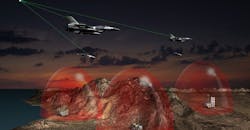Fighter aircraft are among the many military vehicles that rely on GPS technology for navigation and target finding, although they depend on the integrity of the measurements from the GPS receiver. To ensure the quality of navigation and positioning measurements, the U.S. Air Force has revealed that their F-16 aircraft will be the first fighter aircraft to use the latest-generation Digital GPS Anti-Jam Receiver (DIGAR) from Rockwell Collins. This latest version of the GPS technology provides the capabilities to provide highly accurate position, navigation, and timing (PNT) measurements even within highly contested electromagnetic (EM) environments.
The next-generation GPS receivers will be integrated with existing systems to minimize the cost of implementing the new equipment. Specifically, the DIGAR equipment will be employed by the U.S. Air Force Life Cycle Management Center (USAF AFLCMC) to bring reliable timing and navigation functions to U.S. Air National Guard and U.S. Air Force Reserve F-16 aircraft.
“As enemies continue to find new ways to affect the ability to navigate, the latest DIGAR will provide the highest level of protection available so our warfighters can execute missions with precision and accuracy,” said Troy Brunk, vice president and general manager, Communication, Navigation & Electronic Warfare Solutions for Rockwell Collins. The DIGAR provides as many as 16 simultaneous steered beams for excellent jamming immunity and is available in two form factors for integration into existing and forward-looking aircraft designs.
The risks and costs of an upgrade to the DIGAR are minimal, since integration of the receiver requires no changes to existing operational flight programs or A-kit aircraft wiring. The DIGAR is designed on an open architecture and is a form, fit replacement for existing antenna electronic systems. It is meant for use across a variety of aircraft platforms, including rotary wing, fixed-wing fighter, bomber, transport aircraft and small to large unmanned aerial systems.
About the Author
Jack Browne
Technical Contributor
Jack Browne, Technical Contributor, has worked in technical publishing for over 30 years. He managed the content and production of three technical journals while at the American Institute of Physics, including Medical Physics and the Journal of Vacuum Science & Technology. He has been a Publisher and Editor for Penton Media, started the firm’s Wireless Symposium & Exhibition trade show in 1993, and currently serves as Technical Contributor for that company's Microwaves & RF magazine. Browne, who holds a BS in Mathematics from City College of New York and BA degrees in English and Philosophy from Fordham University, is a member of the IEEE.

